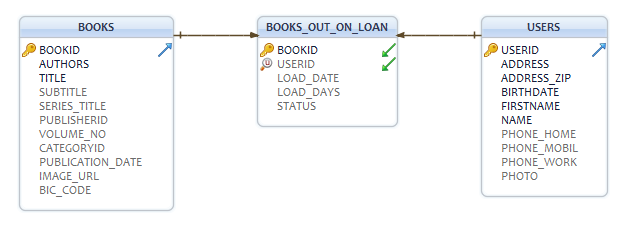Schema of a Database
Databases are software programs for storing data. The data may be stored in Tables . For example:
Table USERS
USERID FIRSTNAME NAME ADDRESS ...
====== ========= ======== ================
1 Franziska Meier Victoria St 12 ...
2 John Smith Tothill St 2 ...
3 Gabriele Merthens Caxton 31 ...
4 Stephanie Jakobi Caxton St 44 ...
5 Elena Jimenez Tothill St ...
6 Peter Baker Cowley St 73 ...
The USERS table stores the users of a library. BOOKS stores the books data, and BOOKS_ON_LOAN records which specifies which books were loan to which user.
The USERID is a number which uniquely identifies each user. Similar with BOOKID, which identifies each book. The table creation SQL is:
CREATE TABLE USERS (
USERID NUMBER( 10 ) NOT NULL,
ADDRESS VARCHAR2( 40 ) NOT NULL,
ADDRESS_ZIP VARCHAR2( 10 ) NOT NULL,
BIRTHDATE DATE NOT NULL,
FIRSTNAME VARCHAR2( 40 ) NOT NULL,
NAME VARCHAR2( 40 ) NOT NULL,
PHONE_HOME VARCHAR2( 30 ),
PHONE_MOBIL VARCHAR2( 40 ),
PHONE_WORK VARCHAR2( 40 ),
PHOTO BLOB,
CONSTRAINT PK_USERS PRIMARY KEY(USERID)) ;
CREATE TABLE BOOKS (
BOOKID NUMBER( 10 ) NOT NULL,
AUTHORS VARCHAR2( 400 ) NOT NULL,
TITLE VARCHAR2( 4000 ) NOT NULL,
SUBTITLE VARCHAR2( 4000 ),
SERIES_TITLE VARCHAR2( 300 ),
PUBLISHERID NUMBER( 10 ),
VOLUME_NO NUMBER( 2 ),
CATEGORYID NUMBER( 10 ),
PUBLICATION_DATE DATE,
IMAGE_URL VARCHAR2( 2000 ),
BIC_CODE VARCHAR2( 60 ),
CONSTRAINT PK_BOOK PRIMARY KEY(BOOKID));
CREATE TABLE BOOKS_OUT_ON_LOAN (
BOOKID NUMBER( 10 ) NOT NULL,
USERID NUMBER( 10 ) NOT NULL,
LOAN_DATE DATE NOT NULL,
LOAN_DAYS NUMBER( 2 ) NOT NULL,
STATUS CHAR( 1 ) NOT NULL,
CONSTRAINT LOAN_PK PRIMARY KEY(BOOKID, USERID, LOAN_DATE),
CONSTRAINT FK_LOAN_BOOKS FOREIGN KEY( BOOKID ) REFERENCES BOOKS ( BOOKID ) ON DELETE CASCADE ON UPDATE CASCADE,
CONSTRAINT FK_LOAN_USERS FOREIGN KEY( USERID ) REFERENCES USERS ( USERID ) ON DELETE CASCADE ON UPDATE CASCADE) ;As you see, each column has a data type ( for example NUMBER ) with a specific precision. The constraints enforces different rules the data has to pass. Like for example the Primary Key ( BOOKID ) which is in fact verified using an unique index on BOOKID.
The foreign key identifies a column or a set of columns in one (referencing) table that refers to a column or set of columns in another (referenced) table. The columns in the referencing table must be the primary key or other candidate key in the referenced table. The values in one row of the referencing columns must occur in a single row in the referenced table. Thus, a row in the referencing table cannot contain values that don't exist in the referenced table (except potentially NULL). This way references can be made to link information together and it is an essential part of database normalization. Multiple rows in the referencing table may refer to the same row in the referenced table. Most of the time, it reflects the one (master table, or referenced table) to many (child table, or referencing table) relationship.
The constraint FK_LOAN_BOOKS is a Foreign Key that enforces that each specified BOOKID from FK_LOAN_BOOKS should exist in the BOOKS table. When a BOOK is deleted from the BOOKS table, the coresponding records from BOOKS_ON_LOAN will be deleted too.
Below you can see a sample diagram with this two tables:
